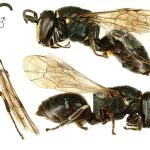The inclusion of this species on the British list is based on a pair of specimens in the Oxford University Museum that carry locality labels, and some literature references. Of the two bees that carry labels, one is a female. This carries only the data “Ham”. This was interpreted by R C L Perkins (1917a) as Hampstead [Middlesex], but there is no firm evidence that this is correct. The other, a male, has more detailed data: “Chelsea, flowers of onion, vii.1827, ex. Coll. J O Westwood, pres. 1857 by Rev. F W Hope. Named 1896 by Edw. Saunders as P. punctatissima”. Smith’s description of the species (Smith, 1845) makes it clear that all his specimens were collected at “Coomb, in flowers...” Alas it has not been possible to trace this locality. There are also two spurious published records from Britain. Smith (1855) states that he met with this species only once, in Birch Wood, West Kent. However, in the second edition of this work (1876) he apparently withdraws this record and indeed gives no locality at all for the species. Saunders (1877) records a male that he collected at Southwold, East Suffolk, in August 1877. This report was probably based upon a misidentification, as it was omitted from his 1896 publication.
A largely Western Palaearctic species, the range extending from Denmark to Iberia, east to Luxembourg, Italy, Turkey, European Russia, Azerbaijan and Israel (Koster, 1986; Ascher & Pickering, 2012).
Shirt (1987) and Falk (1991) both list this species as Extinct (Appendix) in Britain.
No data available.
In mainland Europe the species is univoltine, flying from late May to late August.
Females of this bee utilise borings in dead wood as nest sites.
White melilot, red-berried elder and onion.
No data available.
2018


